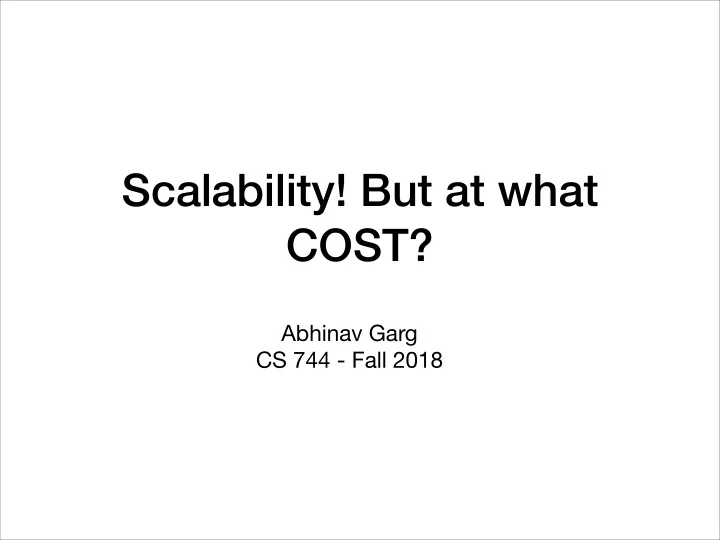

Scalability! But at what COST? Abhinav Garg CS 744 - Fall 2018
Outline • Motivation • Goal • COST • Methodology • Baseline Measurements • Better Baselines • Applying COST to prior work • Take-aways
Which system is better ? Scaling of System A and System B
Which one would you use ? Scaling Performance Naiad computation before (System A) and after (System B) a performance optimization is applied
Motivation • Scalability is considered most important feature • Big data systems may scale well, often because they introduce a lot of overhead • Are systems truly improving performance?
Goal • A new performance metric for big data platforms • Distinguish scalability from e ffi cient use of resources • Weight system’s scalability against overheads • Do not reward systems with substantial but parallelizable overheads
COST • Configuration that outperforms a single thread • Hardware configuration required before platform outperforms competent single threaded implementation
Methodology • Take measurements from recent graph processing publications • Compare against simple single-threaded implementations running on a laptop • Write competent, but not overly fancy algorithms. • Evaluate Page Rank and Graph Connectivity on twitter_rv and uk_2007_05 graphs (GraphX)
Baseline Measurements Elapsed time for 20 Page Rank iterations
Baseline Measurements Elapsed time for Graph Connectivity (using label propagation)
Better Baselines • Improve graph layout • Hilbert Order instead of Vertex Order • (good, good) locality instead of (great, poor) • Reduces TLB misses and page walks
Better Baselines • Improve algorithms • Label propagation scales due to algorithms sub- optimality • Label propagation does more work than better algorithms • Use Union-Find algorithm
Better Baselines Page Rank 179 sec to convert Graph Connectivity Does not ‘think like a vertex’, but parallelizable
Applying COST to prior work 2 1 3 Time per warm iteration Time for 10 iterations from a cold start Scaling measurements for Page Rank on Twitter Graph
Applying COST to prior work • 1- Hash Table based 1 • 2- Array based • Makes trade-o ff 2 clearer Two Naiad implementations of parallel union-find for graph connectivity
Reasons to tolerate high COST • Integration with existing ecosystem • Target variety of problems • High availability, fault tolerance, or security • Technical expertise of the team Think: Do you really need the high COST system?
Take-aways • Understanding overheads is important • Most scalable systems might not be most e ffi cient • Consider alternative hardware and algorithms • Important to evaluate COST - to explain if high COST is intrinsic, to highlight avoidable ine ffi ciencies
Questions ?
References • Frank McSherry, Michael Isard, Derek Murray. Scalability! But at what COST? HotOS, 2015 • http://www.frankmcsherry.org/graph/scalability/cost/ 2015/01/15/COST.html • https://www.youtube.com/watch?v=6bWBEJBMNG0
Recommend
More recommend